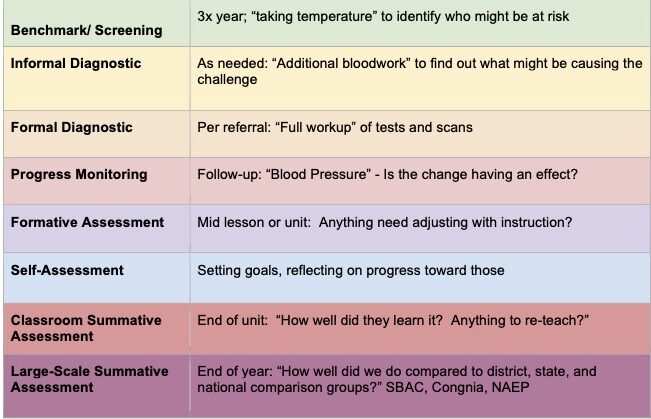Assessment
How Are Students Assessed in WSESU?
Assessment of student progress in WSESU takes many forms. Broadly speaking, we can identify a few basic types of assessment. We use the analogy of a medical check-up to explain these:

WSESU Teaching and Assessment Toolkit
Revised annually, this document provides a blueprint for our local comprehensive assessmen system
Benchmark/ Screening & Progress Monitoring Assessments: Screeners (or Benchmark Assessments) in reading and math are given three times over the course of the year. These are used to help identify those students who may be struggling and in need of additional support at the beginning of the year, at mid-year, and towards the end of the school year. Screeners are generally brief, and results should be highly correlated with other measures of success. If a screener is fairly brief, we can use the same assessment to track individual progress over shorter periods – weeks or months – to fine tune the support being given. This is called “progress monitoring”. Finally, we also use results from screening assessments to track the progress of whole classes over the course of the year. If our instructional program is working, we expect to see fewer students struggling as the year progresses.
Formative Assessment: This is the most prevalent form of assessment, and is part of teachers’ daily practice. Formative assessments are not graded, but rather are used by the teacher to determine next instructional steps. A formative assessment might be an “exit ticket” that is a short response to a question the teacher poses at the end of a lesson. The teacher uses student responses to gauge how well the lesson was learned and to identify what areas might need review and additional instruction the following day. Similarly, a teacher might ask for verbal responses to a question at a pre-planned moment in instruction, knowing from experience that students might be still harboring misconceptions. Next instructional steps in the lesson would be determined by the kinds of response the teacher receives. Homework is often used to determine if students are sufficiently understanding a lesson. Student self-assessment is also a powerful formative assessment tool. As students grow and take more and more responsibility for their own learning, self-assessment takes an ever larger role in their learning journey.
Diagnostic Assessment: Once students are identified as potentially struggling, we can use diagnostic assessment with these individual students to help understand what specific areas of support are needed. Both formal and informal diagnostic assessments are generally performed in a one-to-one setting, and often involve a longer, interview-based format.

Current Benchmark Assessments
For reading starting mid-year in first grade, students are asked to read a standard passage for that grade level, and the number of words read correctly in one minute is used as a predictor of overall success in reading. We are not seeking to have students read as quickly as possible. Rather, we want to use students’ natural reading pace as an indicator of general reading to determine if additional support might be needed. For elementary math, we use an interview where each student is asked a set of math questions covering grade-appropriate math concepts and procedures. At older grades, an online-delivered assessment asks a series of questions designed to predict overall math performance.
Large-Scale Summative Assessment
Through Spring 2022, students in WSESU in grades 3-9 have taken the Smarter Balanced Assessment Consortium (SBAC) for Math and English Language Arts. In Spring 2023, a new assessment – the Vermont Comprehensive Assessment Program (VTCAP) – will be introduced for grades 3-9 (ELA & Math) and grades 5, 8, 11 (Science). Like its predecessor, this assessment takes two or three sessions of about an hour to complete. Results included an overall scale score for all standards and a sub-test score for different components of the assessment.
